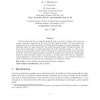316 search results - page 23 / 64 » The chromatic covering number of a graph |
DM
2010
13 years 8 months ago
2010
Let Mad(G) denote the maximum average degree (over all subgraphs) of G and let i(G) denote the injective chromatic number of G. We prove that if Mad(G) 5 2 , then i(G) + 1; sim...
JCO
2007
13 years 8 months ago
2007
We consider the problem of orienting the edges of a graph so that the length of a longest path in the resulting digraph is minimum. As shown by Gallai, Roy and Vitaver, this edge ...
CIE
2006
Springer
14 years 5 days ago
2006
Springer
Abstract. We outline a general theory of graph polynomials which covers all the examples we found in the vast literature, in particular, the chromatic polynomial, various generaliz...
SIAMDM
2008
13 years 8 months ago
2008
We first show that for any bipartite graph H with at most five vertices, there exists an on-line competitive algorithm for the class of H-free bipartite graphs. We then analyze th...
DAM
2011
13 years 3 months ago
2011
An arc of a graph is an oriented edge and a 3-arc is a 4-tuple (v, u, x, y) of vertices such that both (v, u, x) and (u, x, y) are paths of length two. The 3-arc graph of a graph ...

